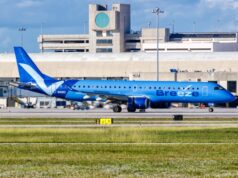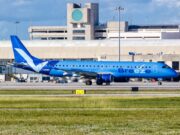
My brain has been into a lot of different topics over the last month and that leads me to contemplate a few separate, but somewhat related, areas in this installment. So, let’s get to it!
On the Current Compensation Environment
One topic I’m repeatedly asked about is the state of the current compensation environment, particularly for pilots. We see the news releases on a daily basis about airlines cutting back on hiring, Spirit possibly filing for bankruptcy, Wheels Up furloughing pilots, etc. I’ve heard several people opine that the pilot shortage is over, and that the aviation industry can “take a breath.” As I’ve said previously, I don’t agree.
We are in the eye of the pilot-hiring storm, an eye largely created by delays in aircraft deliveries to the airlines. Have you taken an airline flight anywhere recently? The terminals are packed with travelers. I’m an American Airlines Admiral’s Club member and there have been times when it’s been standing room only in some of those club facilities. Here’s the takeaway–the demand is still there and it’s not going away. Several of the major airlines have expansion plans and aircraft orders that are still pending. They also have retirement issues to deal with as the Boomer generation continues to age out of the workforce. At the moment, the airlines are working the personnel queue generated in the post-COVID-19 hiring frenzy. Eventually, that queue will be exhausted and pre-COVID-19 hiring levels will likely resume.
In a recent forecast on the business aviation side, deliveries of new aircraft are predicted to total nearly 12,000 units in the 2024-2033 timeframe, with over 1,000 delivered this year alone (McMillin, 2023). No matter how you do the math, that’s a lot of additional personnel required to operate them.
If you’ve been following my articles, you’ve seen the substantial increases in compensation that occurred over the 2023-2024 timeframe for business aviation personnel, an average of greater than 9%, over twice the rate of growth for all personnel in private industry. Higher compensation growth is a function of higher demand for personnel.
There are two ways in which aviation managers and organizations will respond to this environment. One approach is to recognize the temporary nature of this condition, be aggressive in their approach and focus on doing the right thing for their personnel. The other is to take advantage of the perceived lull and ride it out, not stay ahead of the trend and bet that their people will stick around out of sheer loyalty. Good luck with the latter.
On the Nebulous Line Between Captain and Senior Captain
Another question I’m asked on a regular basis is how to differentiate between captain and senior captain. My answer to that question is somewhat non-committal. I usually say: “What do you want it to be?” The rationale for that statement is the nebulous nature of the distinction. But don’t take my word for it, let’s read what the surveys have to say.
First, here are the associated job descriptions from the NBAA Compensation Survey:
Captain: The captain (pilot in command) is responsible for the safe conduct of flights to which they are assigned while ensuring compliance with all federal, state, local and foreign regulations, as well as the policies and procedures specified in the company operations manual. When assigned to a flight, the captain has the final authority in the operation of the aircraft. Captains report directly to the chief pilot.
Senior Captain: The senior captain may have a limited supervisory role of other flight crew in similar makes and models and may be qualified in multiple company aircraft. This position might be responsible for flight operation standardization in assigned makes and models. The senior captain may also have a role as mentor within the flight department. (BDO, 2024)
Now, here are the same job descriptions from the Gallagher Survey:
Captain: Serves as Pilot-in-Command. Responsible for the safety of passengers and crew and the comfortable, timely operation of the aircraft. Supervises the flight crew and ensures that all flight and ground operations comply with FAA Regulations. Determines flight routes, speed, and takeoff and landing times to fulfill scheduling requirements. Makes decisions regarding possible delays, rerouting or flight cancellations. May perform other general department duties when not flying.
Senior Captain: Serves as Pilot-in-Command. Responsible for the safety of passengers and crew and the comfortable, timely operation of the aircraft. Supervises the flight crew and ensures that all flight and ground operations comply with FAA Regulations. Determines flight routes, speed, and takeoff and landing times to fulfill scheduling requirements. Makes decisions regarding possible delays, rerouting or flight cancellations. May manage other functions in the flight department such as Safety Manager and/or Standardization Director. May perform other general department duties when not flying. (Gallagher, 2024)
Notice how closely the two job descriptions for both surveys resemble each other. The only thing that differentiates the two are the duties that a senior captain may have, not will have. This means that use of the job title is totally at the discretion of the organization or manager that bestows it.
One of the reasons the job title exists is due to the nature of HR base-pay structures. In order to justify paying someone more, that person needs to be promoted to a higher pay band, and that requires a different job title. While the job descriptions can be similar, the different job title allows for greater compensation since it lays in a higher band. Don’t think about it too hard. It will make your brain hurt.
After I get past my initial response to the question about captains and senior captains, I typically discuss the pay-band argument, but then I also offer the realities of what I’ve seen. Some organizations differentiate between captain and senior captain based on managerial responsibilities, which can be about leading people or being responsible for job areas, like standards, safety, etc. Other organizations use tenure with the company, experience in the particular aircraft, or experience in the industry as a differentiator.
Keeping in mind that senior captains typically make 10-15% more than captains, the use of the former title should be primarily about compensation levels, not status, but the two are obviously related. The aviation manager should be prepared for pilot angst from all the captains who believe they too should be senior captains but aren’t awarded that title. Happens all the time.
Bibliography
BDO. (2024). 2024 NBAA Compensation Survey. Washington: NBAA.
Gallagher. (2024). 2024 Aviation Compensation Survey. Rolling Meadows, IL: Arthur J. Gallagher & Co.
McMillin, M. (2023, October 9). Aviation Week Forecasts 11,836 Business Aviation Deliveries Over 10 Years. Retrieved from aviationweek.com: https://aviationweek.com/shownews/nbaa/aviation-week-forecasts-11836-business-aviation-deliveries-over-10-years



















































































































